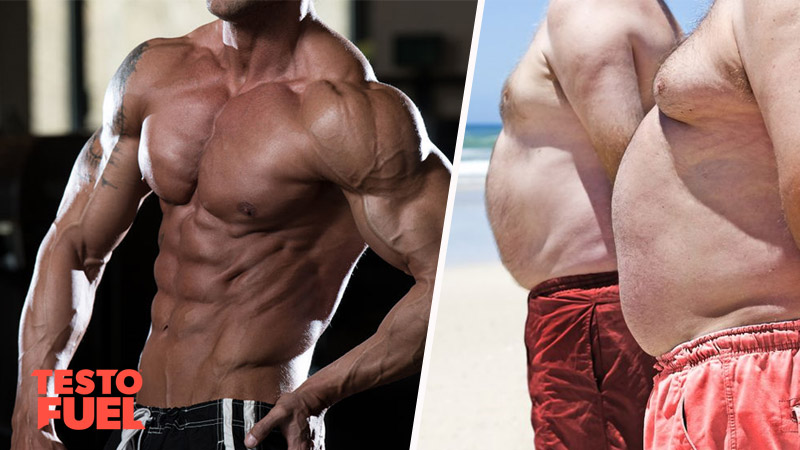TestoFuel Blog : Make Gains & Pack on the Muscle

When your hormone levels are ticking over smoothly you feel and look better. You’re confident and muscular, assertive and healthy.
But as your levels begin to drop you’ll find a number of side effects begin to creep upon you – loss of muscle, lack of energy and low libido for example.
In this article we’ll take a look at gynecomastia – a problem that more and more men are suffering from.
What is it? How does it feel and what does it look like?
Let’s take a look…
When testosterone (T) levels are optimized, you are the epitome of masculinity. From your muscular frame and your chiseled abs to your assertive, commanding presence and square jaw; you are everything a woman wants.
As a naturally-occurring steroid hormone, T controls everything from your protein synthesis and muscle cell turnover rate to your body hair and tone of voice. This means that it is responsible for both anabolic and androgenic characteristics.
Here are the main roles of testosterone:
During fetal development, the T you are exposed to plays an important role in shaping your development. It drives your male reproductive development and has strong links to what you’ll become in future years.
After birth, and prior to the onset of puberty, a boy will have limited T in their blood. It measures around 7 – 130 ng.dL.
As soon as adolescence hits though, you experience a big spike in how much male hormone is pumped out of your testes and into your bloodstream. And from that point on your T levels remain high throughout your teens and twenties – around 300 – 1,000 ng.dL
While you experience the pleasures of life and the benefits of high testosterone throughout your early years, you start to experience a gradual decline in hormone levels from around 30 years old.
Testosterone drops by around 1 – 2 percent each year from then on. By the age of 40, some males will drop below the 300 ng.dL lower normal threshold.
And by 60 years old most men will be below that threshold too. Being diagnosed as having clinically low testosterone – or hypogonadism – has big implications for your health going forward.
These implications include:
Otherwise known as gyno, male breasts or man boobs, gynecomastia refers to an enlargement of breast tissue.
Gyno is common during/ infancy, in teenage boys and also in older men but can affect anyone with low testosterone levels.
According to one study, gynecomastia is indicated by “benign enlargement of the male breast due to growth of glandular tissue” [1].
It is characterized by fatty deposits and enlarged breast gland tissue, and caused by a hormonal imbalance.
But don’t let the fact that it is ‘fatty deposits’ confuse you though as gyno is different to just being being overweight and carrying too much body fat.
Symptoms include tenderness and swollen tissue around the chest area.
A male breast-like increase in fat comes from a growth in soft tissue both behind and around the nipple. That means that even when you tense your pectoral muscles there’ll still be a feeling of soft, flabby padding there, even though the muscle underneath might feel firm.
Your nipple might appear puffy or erect. You may even find a small lump when examining yourself that signifies a fatty deposit.
Currently, it is said that between 30 – 65% of men have enlarged breast tissue. In young boys it is as high as 70% due to massive fluctuations in hormones during development from an adolescent into a man.
In one study, 37% of 306 men showed symptoms of enlarged breast tissue [2]. In 7 of those men, gyno only affected one side of their body, whereas in all others it was bilateral – it affected both sides.
It’s worth noting that when men over 44 were analyzed separately to the younger volunteers, the number of men showing signs of the disorder went up to 57% – a big increase.
Causes of gynecomastia can include low thyroid function, kidney disorders. obesity and cirrhosis of the liver.
But the most likely cause is hypogonadism or low T.
As we’ve already mentioned, the development of gyno is related to an imbalance of hormones. And the main ones you need to know about are estrogen and testosterone.
Estrogen is typically associated with women. As levels of this hormone begin to increase in your body, testosterone deceases. They work a little like the gas and brake in your car.
Yes you can.
Starting an eating plan revolving around nutritious and healthy foods coupled with a program of strength training and cardio are important in fighting the war against man boobs.
You can opt for surgery, however this is both invasive and expensive. It carries the inherent risk of infection or post-operative side effects too.
Your main focus shouldn’t be to treat the symptoms but the cause. You need to fix your low testosterone levels.
Freeing yourself of the symptoms of gynecomastia can be difficult. It takes a full turnaround of your lifestyle and management of a number of different aspects of your life.
Remember, the cause of your gyno is more than likely down to low testosterone levels. Optimizing your hormone levels should be the priority.
Here’s how to get started on that journey: